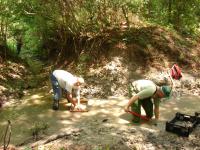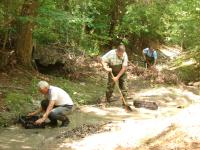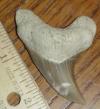Welcome to Dutch Creek - an American Fossil Hunting Experience

For over a year now Willem, Cor, Hans, Renee, and Bill have been planning a vacation of a lifetime to the United States from Holland. They contacted me last year and asked me if I would consider taking them fossil hunting during their visit. They were on a hunt for megalodon teeth. Megalodon was a giant shark that died about 1 or 2 million years ago whose fossilized teeth can reach 7 inches or more. Megalodon teeth are found in relative abundance on the East Coast of the United States, especially in North and South Carolina. In exchange for showing them my prized hunting grounds in South Carolina, they would give me a collection of teeth from the Netherlands, Belgium, Germany, France, and Morocco. Never having met a true Dutchman face to face, I jumped at the opportunity to expand my horizons and we began making plans for their visit. They needed to handle things like hotel reservations, plane tickets, passports, and a way to get their shovels onboard the airplane.
Fossil Hunting in North Carolina

After a year of sending emails to each other, the Dutchmen and I finally met in Aurora, North Carolina at the PCS phosphate mine known to collectors as Lee Creek. My guests left Charleston SC as soon as their plane landed so they could make the date with this quarry, and they were kind enough to allow me to tag along on their quest for a Yankee megalodon. Access to the PCS mine is by appointment only, so it was a real treat to be able to collect this location. As they mine phosphate, the immense draglines cast off hundreds of feet of overburden into giant mounds, laden with fossils. Entire careers have been spent studying the extreme diversity of prehistoric life found there, and it is one of the best places anywhere to find a megalodon tooth. Most people do what’s called “Surface collecting” there – basically a fancy way of saying you walk around and pick up fossils. But it takes a little more skill than that because you have to know what the sediments look like that have the fossils. Everything is basically grey. Or Grey with shells. Or black. Or Black with shells. Or just shells. It can be quite confusing to a beginner. Luckily, guides accompany collectors on their visits and are quite willing to let everyone in on the best places to look. With our inside edge, we were able to find many different shark teeth species, some as old as 25 million years but there was no megalodon tooth for our collector friends from across the sea. Still, we were thankful for the opportunity to collect such a wonderful location. The next day was spent outside the Aurora Fossil Museum, sifting the spoil piles for small teeth. Besides allowing people to enter their property collect fossils, PCS phosphate also provides truckloads of material to the museum for people to search. Shark teeth are big in Aurora. Each year the town sponsors the Aurora Fossil Festival which attracts thousands of visitors to the tiny town. The streets are decorated with shark tooth flags. Collectors from diverse locations display their fossils. There is an auction to support the museum, and there is even a parade – all around the humble shark tooth. The next Fossil Festival is the weekend of May 23 – 24, 2008.
Fossil Hunting in South Carolina
The meat of the Dutch fossil extravaganza was to take place in the Lowcountry of South Carolina, where I am somewhat familiar with the terrain. I took the Dutchmen to some of my favorite spots where they spent six days hunting for shark teeth. Different locations require different techniques. The most common is called sifting and it involves shoveling sediment into a specially constructed box with a wire mesh screen at the bottom to trap larger particulates when the material is rinsed in the water. Another method, though simpler requires a lot more effort – you just dig a hole. In some special locations, the geologic formations that have megalodon shark teeth and other fossils are close enough to the surface to be accessible. With just a shovel and determination, the fossil bearing layers are exposed and with a little luck, there will be something there.
Digging for Shark Teeth

The first day we got permission and went to land site. Land sites are where teeth and other fossils can be found on land, without the need for scuba diving equipment. The guys worked all day digging holes to reach the fossil bearing deposits. Then, they carefully sifted the deposits to separate the good from the bad and the ugly. They found loads of teeth, but again no complete megalodon teeth. However, they did find their first angustidens teeth, and that was a big deal. What’s the big deal, why is angustidens so special? It doesn’t even have an English name. Angustidens is the evolutionary grandfather of megalodon that lived about 30 million years ago. It didn’t get quite as big, but its teeth can still be over 5 inches long. And unlike megalodon, each angustidens tooth is three teeth in one! Not really, but they look like it. In addition to the main “tooth”, each angustidens has little side “teeth” called cusps that stick out from the main “tooth”. The digging finally took its toll, and the Dutchmen called it quits on day one of their South Carolina fossil vacation.
Fossil Expeditions in South Carolina

The second day of Bill, Cor, Willem, Hans, and Renee’s visit, I had an early meeting so I couldn’t hunt with my new friends from Holland, but I took them to another spot where they could easily enjoy another day of collecting. This location was a stream that cuts through the fossil formation formation, so the previous night’s rainfall meant a good possibility for various shark species known from South Carolina including megalodon, angustidens, tigers, threshers, sand tigers, snaggletooth, and even the teeth of early whales. Rainfall is good because the higher water levels erode fossils from the banks of the stream so collectors can spot them by site. This location also has some sediments on the bottom that can be sifted. When I used to live closer to this spot, I rode my bike there on an almost daily basis and really found a lot of prize specimens, so I hoped they would fare as well.
Sifting for Shark Teeth

As I met up with the group the third day, they were all happy again with the results of the previous day with good finds all around. This day, I took them to the Yellow Ditch, my favorite spot for the last few years. It has had various names, including the Home Creek because it is close to my home, the Dumping Grounds because some of its finer residents dispose of their garbage there, and a few others, but I just recently settled on ‘Yellow Creek’ because so many of the fossils there were yellow… or white, or orange, or blue, or grey, or green, or gold. Everyone settled into a spot and began systematically shoveling gravel into a sifter, sifting the gravel to remove find sediment and clay, meticulously picking through the gravel to pull out teeth, and dumping the gravel on the edge just to repeat the entire process until loss of blood to mosquitoes and swollen vertebrae broke their wills. The great finds started almost immediately. Hans and Cor were hunting together about 25 yards downstream from me when I first heard the telltale whoops of elation. A grinning Hans approached, his hands cupped together. I thought – “if its enough to make him quit digging, it must be pretty good,” and it was.

Parotodus! And it was a big one too. Over 2 ½ inches of yellow, white, blue, orange, green, beefy best find of the trip. I would not have guessed that tooth would be in that ditch. I’ve never even found a piece of one there before, but it was an awesome find to be sure. To anyone not familiar with the species, Parotodus benedeni – aka False Mako Shark, is an evolutionary oddity in sharks. Scientists believe this deep water shark evolved from the same roots as Megalodon, Great White, Mako, and the other big sharks of the day, but dead ended at extinction during the Pliocene. The teeth are stout, smooth edged daggers with a wicked curve. Their thick, bulbous U shaped roots are their most distinctive feature. Parotodus lived as a genus for almost 50 million years. Collectors prize this species for its rarity and because it can grow very large with the biggest specimens well over 3 inches. I’ve heard rumors about a 4 inch monster from Sharktooth Hill in Bakersfield California. Regardless, this day’s collecting was filled with excellent finds, with everyone recovering at least one tooth that would qualify the day as successful.
More Fossil Hunting in Creeks


After the first day at the Yellow creek, Hans, Bill, Cor, Willemm and Renee didn’t want to try another spot. They were happy to repeat the previous day’s finds again. The quality and diversity of the fossils at this location is high, so they felt no need to hunt anywhere else. Soon after we started collecting on the second day, Renee skipped down the creek to show off a beautiful modern great white shark (Carcharodon carcharias) tooth - 2 inches long - that he had sifted. The tooth was complete with root and every serration and was a stunning mixture of colors. The colors are attributed to the minerals present when the tooth fossilized. Like the reddish tint so familiar in iron rust, iron in the ground causes fossils to be red also. Other minerals produce other colors. A bit later in the day, Bill showed off a beautiful reef shark tooth. Known by collectors by its more sterile scientific name, Carcharoides catticus, this tooth is not as glamorous as those of its larger cousins, but what it lacks in size it gains in scarcity. These teeth are seldom found in any condition, and this was a gem! Then Cor found a beautiful angustidens. It seemed like the finds kept coming all day long.
After a day trip to the Richlands quarry in North Carolina, and then to the Aurora Fossil Museum PCS spoil piles, Cor, Hans, Renee, Bill, and Willem returned to Dutch Creek for the final days of vacation. Day after day, the finds mounted as the creek bed fell, its contents methodically sifted, the fossils removed, and the remaining gravel thrown up on the banks. Trash was removed. Where once a solid rocky surface existed is now a jumble of loose sand, pebbles, and most importantly - rich fossil bearing geologic formations. It’s as if some human powered earthmoving machine scooped the bottom of the creek. This is now a completely different location, so much so that the Yellow ditch deserves a new name. From now on, its official Black River Fossils name is “Dutch Creek.”
The End of the Expedition
At the end of the trip, the Dutch collectors seemed very satisfied with their vacation. Except for a few shopping outings and some unsuccessful attempts to see an alligator in the wild, these days were spent collecting fossils, which was the main purpose of their visit to North and South Carolina. Each had added many prize specimens to his collection and lived a different fossil hunting existence.